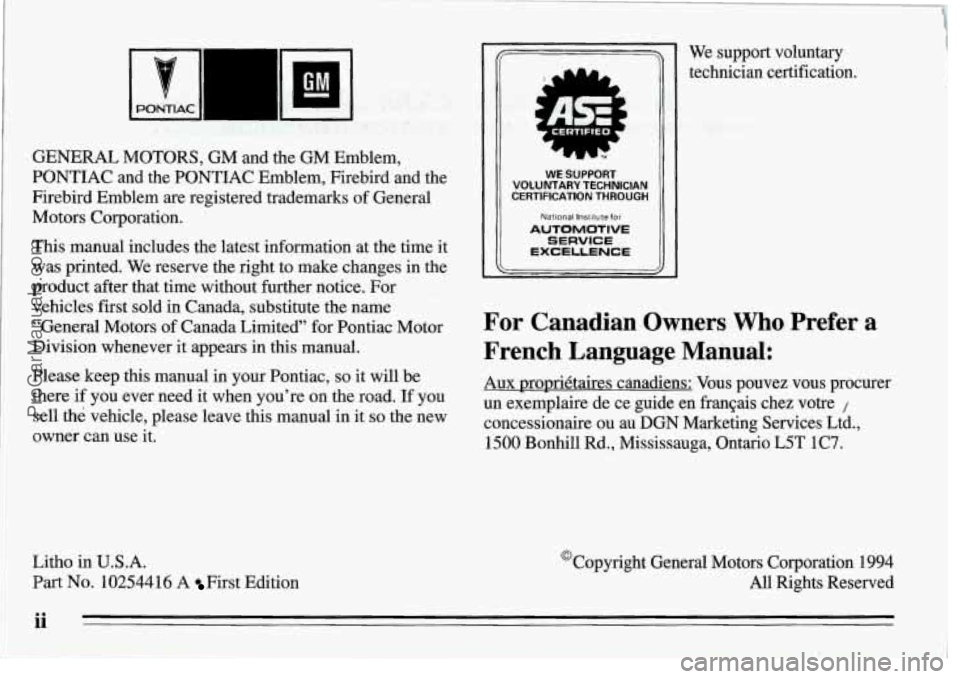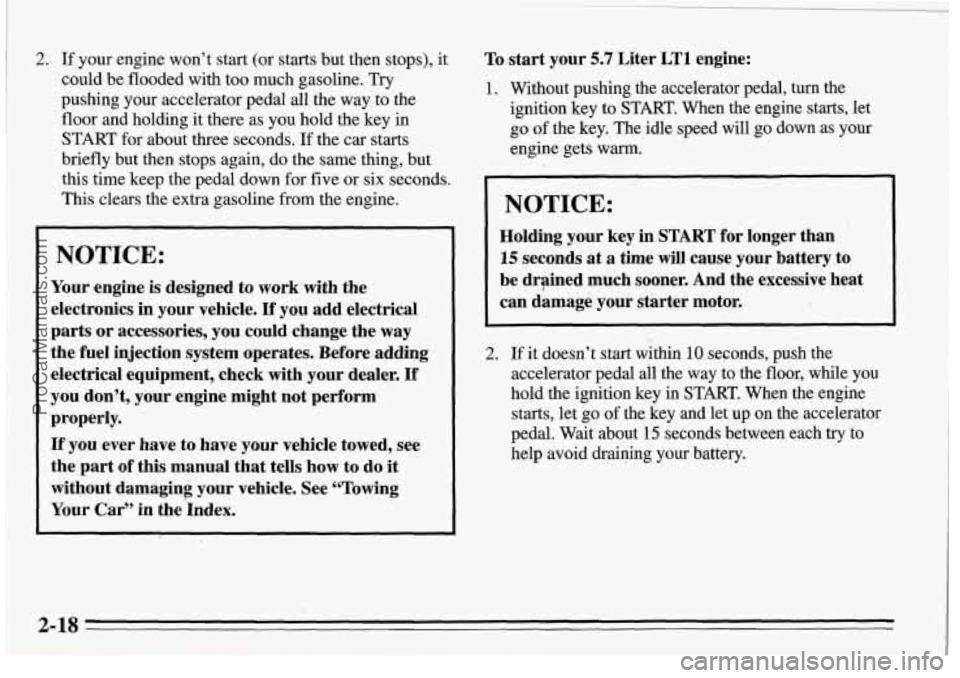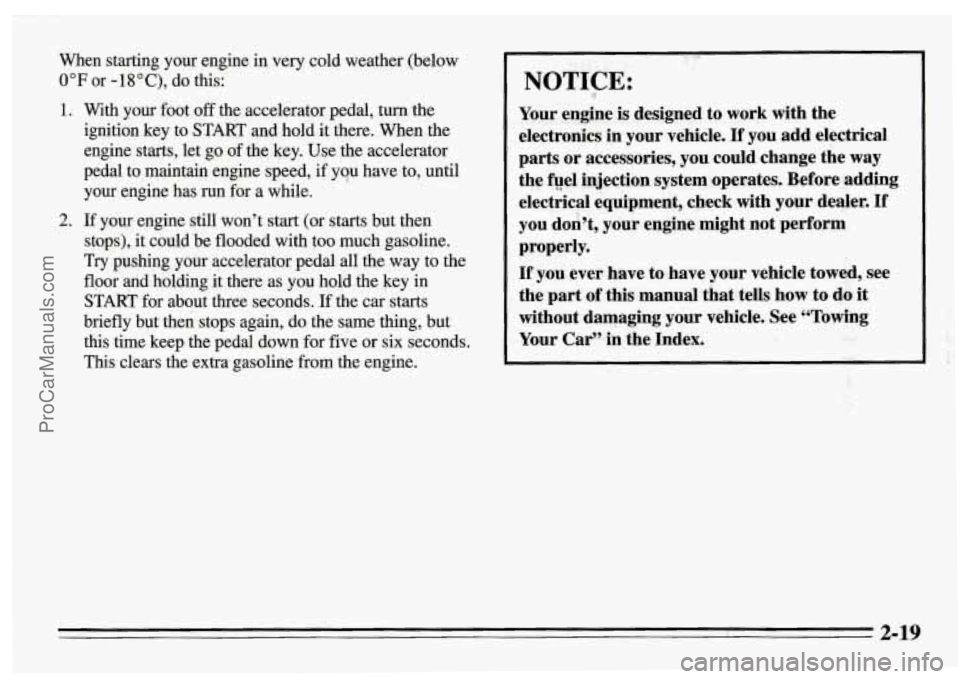change time PONTIAC FIREBIRD 1995 Owners Manual
[x] Cancel search | Manufacturer: PONTIAC, Model Year: 1995, Model line: FIREBIRD, Model: PONTIAC FIREBIRD 1995Pages: 386, PDF Size: 19.66 MB
Page 3 of 386

.I
I PONTIAC I I
GENERAL MOTORS, GM and the GM Emblem,
PONTIAC and the PONTIAC Emblem, Firebird and the
Firebird Emblem are registered trademarks of General
Motors Corporation.
This manual includes the latest information at the time it
was printed. We reserve
the right to make changes in the
product after that time without further notice. For
.
vehicles first sold in Canada, substitute the name
“General Motors
of Canada Limited’’ for Pontiac Motor
Division whenever
it appears in this manual.
Please keep this manual in your Pontiac, so it will be
there
if you ever need it when you’re on the road. If you
sell the vehicle, please leave this manual in it so the new
owner can use it.
Litho in U.S.A.
Part No. 10254416 A First Edition
k
We support voluntary
WE SUPPORT VOLUNTARY TECHNICIAN CERTIFICATION THROUGH
National Institute for
AUTQMOTIVE SERVICE EXCELLENCE
I technician certification.
For Canadian Owners Who Prefer a
French Language Manual:
Aux propri6taires canadiens: Vous pouvez vous procurer
un exemplaire de ce guide en
fransais chez votre /
concessionaire ou au DGN Marketing Services Ltd.,
1500 Bonhill Rd., Mississauga, Ontario L5T
1C7.
@Copyright General Motors Corporation 1994
All Rights Reserved
ii
1
ProCarManuals.com
Page 55 of 386

3. Insert the other end of the fused jumper into terminal
4. Terminal 4 is the fourth terminal from the left in
the top row.
You have grounded the program input line. You
should hear the door locks lock and unlock within
one to three seconds.
When matching transmitters, the fiist transmitter
code matched will be stored in both memories until a
second transmitter is matched.
This means that the
second transmitter
will not work until it is matched
in step
5.
locks should lock and unlock.
4. Press any button on the first transmitter. The door
Battery Replacement
Under normal use, the batteries in your key chain
transmitter should last about two years.
You can tell the batteries are weak if the transmitter
won’t work at the normal range in any location.
If you
have to get close
to your vehicle before the transmitter
works, it’s probably time to change the batteries.
Use two batteries, type DL2016, or similar type.
To replace batteries in the Remote Lock Control:
1. Pop the cover off by inserting a dime (or similar
2. Lift
off the front cover, bottom half first.
object) in the slot between the covers and twisting.
5. Press any button on the second transmitter. The door
locks should lock and unlock.
6. Remove the fused jumper from the DLC. The system
7. Check that all the buttons on both transmitters work
will not ‘work unless the jumper is removed.
correctly.
If the transmitters don’t work, or if you’d rather not
match the transmitters yourself, see your Pontiac
dealer.
2-8
ProCarManuals.com
Page 65 of 386

2. If your engine won’t start (or starts but then stops), it
could be flooded with too much gasoline. Try
pushing your accelerator pedal all the way to the
floor and holding it there as you hold the key in
START for about three seconds. If the car starts
briefly but then stops again, do the same thing, but
this time keep the pedal down for five or six seconds.
This clears the extra gasoline from the engine. ~ ~
NOTICE:
Your engine is designed
to work with the
electronics in your vehicle.
If you add electrical
parts or accessories9 you could change the
way
the fuel in&tion system operates. Before adding
electrical equipment, check with your dealer.
If
you don’t, your engine might not perform
properly.
If you ever have to have your vehicle towed, see
the part
of this manual that tells how to do it
without damaging your vehicle. See “Towing
Your Car” in the ‘Index.
To start your 5.7 Liter LT1 engine:
1. Without pushing the accelerator pedal, turn the
ignition key to START. When the engine starts, let
go
of the key. The idle speed will go down as your
engine gets
warm.
I
NOTICE:
Holding your key in START for longer than
15 seconds at a time will cause your battery to
be drained much sooner. And the excessive heat
can damage your starter motor.
2. If it doesn’t start within 10 seconds, push the
accelerator pedal all the way to the floor, while you
hold the ignition key in START. When the engine
starts, let go
of the key and let up on the accelerator
pedal. Wait about
15 seconds between each try to
help avoid draining your battery.
2-18
ProCarManuals.com
Page 66 of 386

When starting your engine in very cold weather (below
0°F or -18"C), do this:
1. With your foot off the accelerator pedal, turn the
ignition key to START and hold it there. When the
engine starts, let
go of the key. Use the accelerator
pedal to maintaiq engine speed, if you have to, until
your engine has run for
a while.
stops), it could be flooded with too much gasoline.
Try pushing your accelerator pedal all the way to the
floor and holding it there as you hold the key in
START for about three seconds. If the
car starts
briefly but then stops again,
do the same thing, but
this time keep the pedal down for five or six seconds.
This clears the extra gasoline from the engine.
2. If your engine still won't start (or starts but then
' NOTICE:
- Ir
7
Your engine is designed to work with the
electronics in your vehicle.
If you add electrical
parts or accessories, you could change the
way
the fuel injection system operates. Before adding
electrical equipment, check with your dealer.
If
you don't, your engine might not perform
properly.
If you ever have to have your vehicle towed, see
the part of this manual that tells how to do
it
without damaging your vehicle. See "Towing
Your Car" in the Index.
' 4+
2-19
ProCarManuals.com
Page 136 of 386

Defogging and Defrosting the Windshield
1. Turn the air control knob to DEFROST.
2. Turn the temperature control knob to the desired
setting.
3. Turn the fan control knob to the desired speed.
Air Conditioner Controls (Option)
The air conditioning system uses the same controls as the
heating system, except that the
slir control knob has two
extra settings, described below. For an explanation of all
the controls, see “Heater Controls” earlier in this part.
MAX: Provides maximum cooling or quick cool-down
on very hot days.
This setting recirculates most of the air
inside your vehicle. If it is used for long periods of time,
the
air may become dry. This setting directs air through
the upper air vents.
A/C: Use for normal cooling on hot days. This setting
cools outside
air and directs it through the upper air vents.
The air conditioner compressor operates in MAX, A/C,
BI-LEVEL, BLEND and DEFROST when the outside
temperature is above freezing. When the
air conditioner
is on, you may sometimes notice slight changes in your
vehicle’s engine speed and power.
This is normal because
the system is designed to cycle the compressor on and
off
to keep the desired cooling and help fuel economy.
Cooling
The air conditioner works best if you keep your
windows closed. On very hot days, open the windows
just long enough for the hot air to escape.
1. Turn the air control knob to A/C for normal cooling.
For faster cooling move the knob to MAX.
2. Turn the temperature control knob to a comfortable
3. Move the fan cdfitrol knob to the desired speed.
setting.
3-3
ProCarManuals.com
Page 159 of 386

Remember: Anti-lock doesn’t change the time you need
to get your foot up to the brake pedal.
If you get too
close to the vehicle in fiont of you, you won’t have time
to apply your brakes if that vehicle suddenly slows or
stops. Always leave enough room up ahead to stop, even
though you have anti-lock brakes.
To Use Anti-Lock
Don’t pump the brakes. Just hold the brake pedal down
and let anti-lock work for you. You may feel the system
working, or you may notice some noise, but this
is
normal. When your anti-lock system is adjusting brake
pressure to help avoid a braking skid,
the LOW TRAC
light
will come on. See “LOW Traction Light” in the
Index.
Traction Control System
(Option:
LT1 V8 Engine)
Your vehicle may have a traction control system that
limits wheel spin. This is especially useful in slippery
road conditions: The system operates only if it senses
that one or both of the rear wheels are spinning or
beginning to lose traction.
When this happens, the system works the rear brakes
and reduces engine power
(by closing the throttle and
managing engine spark) to limit wheel spin.
The LOW TRAC light will come on when your traction
control system is limiting wheel spin. See “Low Traction
Light” in the Index.
You may feel the system working, or
you may notice some noise, but this
is normal.
The traction control system may operate on dry roads
under some conditions, and
you may notice a reduction
in acceleration when
this happens. This is normal and
doesn’t mean there’s a problem with your vehicle.
Examples of these conditions include a hard acceleration
in a
turn, or an abrupt upshift or downshift.
4-8
ProCarManuals.com
Page 162 of 386

Braking in Emergencies
Use your anti-lock braking system when you need to.
With anti-lock, you can steer and brake at the same
time. In many emergencies, steering can help you more
than even the
very best braking.
Steering
Power Steering
If you lose power steering assist because the engine
stops or the system is not functioning, you can steer but
it will take much more effort.
Steering Tips
Driving on Curves
It’s important to take curves at a reasonable speed.
A lot of the “driver lost control” accidents mentioned on
the news happen on curves. Here’s why:
Experienced driver or beginner, each of us is subject to
the same laws of physics when driving on curves. The
traction of the tires against the road surface makes it
possible for the vehicle to change its path when you
turn
the front wheels. If there’s no traction, inertia will keep
the vehicle going in the same direction. If you’ve ever
tried to steer a vehicle on wet ice, you’ll understand this\
.
The traction you can get in a curve depends on the
condition of your tires and the road surface, the angle at
which the curve is banked, and your speed. While
you’re in a curve, speed is the one factor you can
control.
Suppose you’re steering through a sharp curve. Then
you suddenly accelerate. Both control systems
--
steering and acceleration -- have to do their work where
the tires meet the road. Unless you have traction control
and the system is on, adding the sudden acceleration can
demand too much of those places. You can lose control.
Speed limit signs near curves warn that you should
adjust your speed. Of course, the posted speeds are
based
on good weather and road conditions. Under less
favorable conditions you’ll want to go slower.
If you need to reduce your speed as you approach a
curve, do it before you enter the curve, while your front
wheels are straight ahead.
Try to adjust your speed so you can “drive” through the
curve. Maintain
a reasonable, steady speed. Wait to
accelerate until you are out of the curve, and then
accelerate gently into the straightaway.
4-11
ProCarManuals.com
Page 165 of 386

Do not get too close to the vehicle you want to pass
while you’re awaiting
an opportunity. For one thing,
following too closely reduces your area of vision,
especially if you’re following a larger vehicle.
Also,
you won’t have adequate space if the vehicle ahead
suddenly slows or stops. Keep back a reasonable
distance.
When it looks like a chance to pass is coming up,
start to accelerate but stay in the right lane and don’t
get too close. Time your move
so you will be
increasing speed as the time comes to move into the
other lane.
If the way is clear to pass, you will have a
“running start” that more than makes up for the
distance you would lose by dropping back. And
if
something happens to cause you to cancel your pass,
you need only slow down and drop back again and
wait for another opportunity.
If other cars are lined up to pass a slow vehicle, wait
your turn. But take care that someone isn’t trying to
pass you as you pull out to pass the slow vehicle. Remember
to glance over your shoulder and check
the blind spot.
Check your mirrors, glance over your shoulder, and
start your left lane change signal before moving out
of the right lane to pass. When you are far enough
ahead of the passed vehicle to see its front in your
inside mirror, activate your right lane change signal
and move back into the right lane. (Remember that
your right outside mirror is convex. The vehicle you
just passed may seem to be farther away from you
than it really is.)
Try not to pass more than one vehicle at a time on
two-lane roads. Reconsider before passing the next
vehicle.
Don’t overtake a slowly moving vehicle too rapidly.
Even though the brake lights are not flashing, it may
be slowing down or starting to turn.
If you’re being passed, make it easy for the
following driver to get ahead of you. Perhaps you
can ease a little
to the right.
4-14
ProCarManuals.com
Page 183 of 386

Your car can tow a trailer if it is equipped with the
proper trailer towing equipment. To identify what the
vehicle trailering capacity is for your vehicle, you
should read the information in “Weight
of the Trailer”
that appears later in this section. But trailering is
different than just driving your vehicle by itself.
Trailering means changes in handling, durability, and
fuel economy. Successful, safe trailering takes correct
equipment, and it has to be used properly.
That’s the reason for this part. In it are many
time-tested, important trailering tips and safety rules.
Many of these are important for your safety and that of
your passengers.
So please read this section carefully
before you pull a trailer.
Load-pulling components such as the engine,
transmission, rear axle, wheel assemblies, and tires
are
forced to work harder against the drag of the added
weight. The engine is required to operate at relatively
higher speeds and under greater loads, generating extra
heat. What’s more, the trailer adds considerably to wind
resistance, increasing the pulling requirements.
If You Do Decide To Pull A Trailer
If you do, here
are some important points.
0 There are many different laws, including speed limit
restrictions, having to do with trailering. Make sure
your rig will be legal, not only where you live but
also where you’ll be driving.
A good source for this
information can be state or provincial police.
Consider using a sway control.
You can ask a hitch dealer about sway controls.
0
0
0
Don’t tow a trailer at all during the first 1000 miles
(1 600 km) your new vehicle is driven. Your engine,
axle or other parts could be damaged.
Then, during the first 500 miles (800 km) that you
tow a trailer, don? drive over
50 mph (80 km/h) and
don’t make starts at full throttle. This helps your
engine and other parts of your vehicle wear in at the
heavier loads.
Obey speed limit restrictions when towing a trailer.
Don’t drive faster than the maximum posted speed
for trailers (or no more than
55 mph (90 km/h)) to
save wear on your vehicle’s parts.
ProCarManuals.com
Page 255 of 386

4. Open the air cleaner and remove the filter.
Automatic Transmission Fluid
When to Check and Change
A good time to check your automatic transmission fluid
level is when the engine oil is changed. Refer to the
Maintenance Schedule to determine when to change
your fluid. See “Scheduled Maintenance Services” in the
Index.
How to Check
Because this operation can be a little difficult, you may
choose to have this done at your Pontiac dealer Service
Department.
If you do it yourself, be sure to- follow all the
instructions here, or you could get a false reading on the dipstick.
NOTICE:
Too much or too little fluid can damage your
transmission.
Too much can mean that some of
the fluid could come out and fall on hot engine
parts or exhaust system parts, starting a fire. Be sure to get an accurate reading if you check your
transmission fluid.
.
6-22
ProCarManuals.com